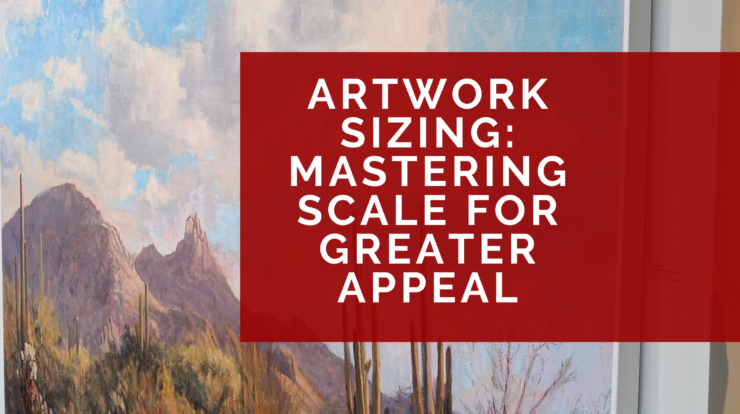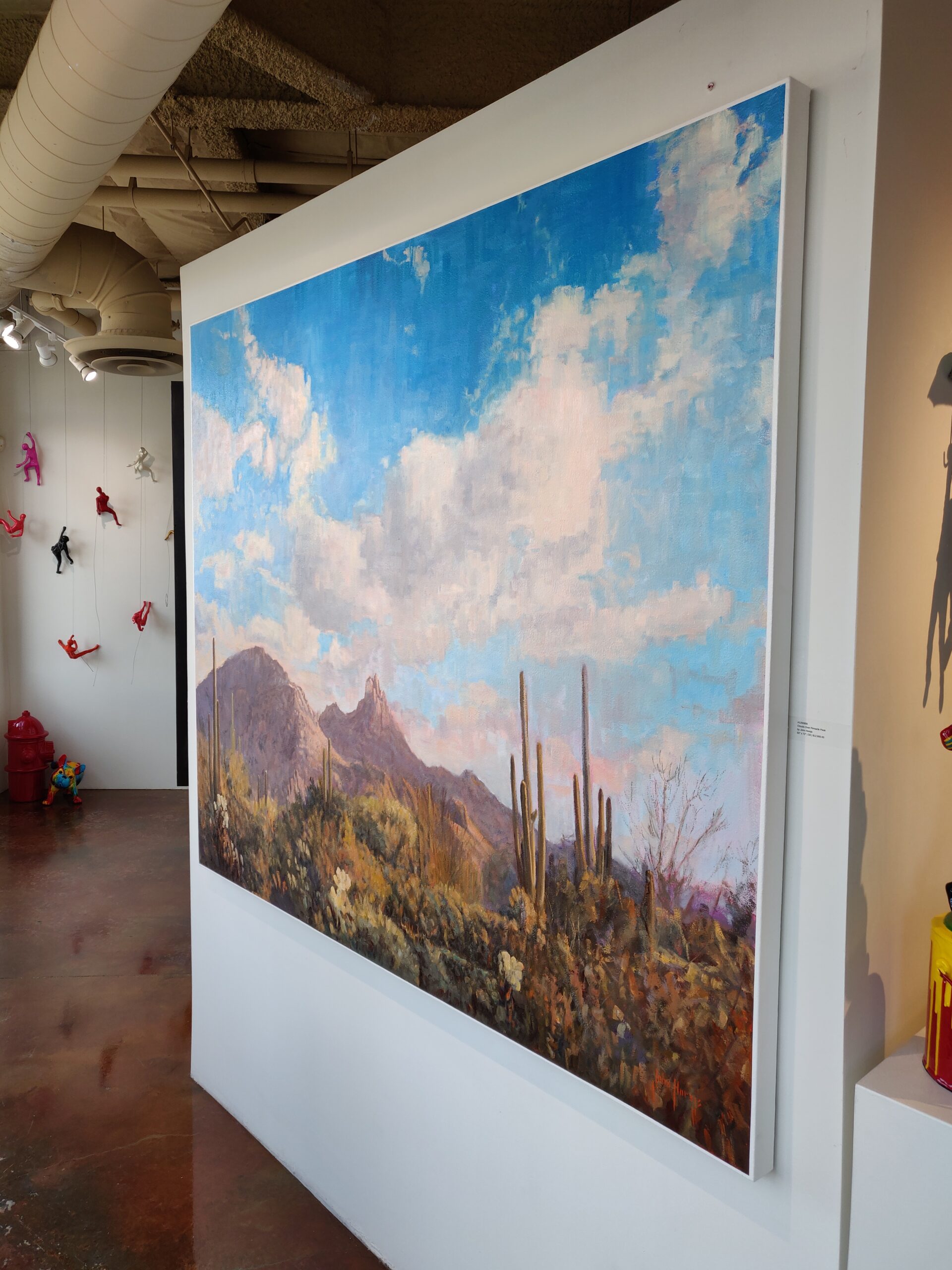
In the art world, the size of your canvas or sculpture is more than just its physical dimensions; it’s a key element that can significantly impact how you connect with your audience and stand out in the market. From my experience as a gallery owner, I’ve noticed that the size of artwork often doesn’t get the attention it deserves, yet it plays a crucial role in an artist’s success. It’s a tool that you, as an artist, can use not just for creative expression but also to align with market trends, meet collector preferences, and fulfill gallery requirements.
Today, let’s explore how your artwork’s size affects everything from how people perceive art to the practicalities of making and exhibiting it. I’ll share insights on why varying the sizes in your work can open doors to a wider audience, appealing to a broader spectrum of art lovers and buyers. Understanding the strategic use of size in your art is an essential yet often overlooked aspect of a thriving artistic career.
The age-old question of “what size artwork sells best” is more complex than it appears. While smaller artworks often sell in higher volumes due to their affordability, larger pieces, though they might sell less frequently, can command higher prices and offer substantial financial returns. For instance, in my gallery, smaller artworks, like 5×5 or 6×9 pieces, fly off the walls, but larger, monumental pieces, although they take longer to sell, can be game-changers when they do.

The size of an artwork does more than fill a physical space; it plays a pivotal role in shaping the viewer’s psychological response. In my years of gallery management, I’ve observed firsthand how the dimensions of a piece can dramatically alter perception and engagement.
Large-scale artworks command immediate attention. Their sheer size can evoke a sense of awe and wonder, making them not just art pieces but experiential phenomena. When a viewer encounters a large painting or sculpture, it often becomes more than just viewing; it’s an immersive experience. For instance, I recall a striking 72×72 painting that dominated our gallery space. It wasn’t just seen; it was felt. The magnitude of the piece created an undeniable presence, transforming the gallery into a realm of the artist’s vision.
This impact extends beyond the visual appeal. Large artworks can set a psychological anchor in terms of pricing. When placed strategically, a high-priced, large piece can make moderately priced smaller works appear more accessible and desirable. It’s a subtle yet effective way of guiding a collector’s decision-making process. For example, a collector might balk at a $5,000 piece until they see a $20,000 masterpiece. Suddenly, the smaller work becomes a more attainable entry point into the artist’s world.
On the other end of the spectrum, smaller works have their own psychological appeal. They often feel more intimate and personal, inviting close-up interaction. Smaller pieces can also appear more collectible, encouraging viewers to envision owning multiple works. The affordability of smaller works broadens their appeal, enabling art enthusiasts of various economic backgrounds to engage with and purchase original art.
Moreover, the size of an artwork can reflect and evoke different emotional responses. Large works might speak of boldness and confidence, while smaller works might communicate delicacy and thoughtfulness. As artists experiment with size, they also play with these psychological perceptions, tailoring their work to convey specific messages or evoke particular emotions.
Diversifying the size of your artwork offers several advantages. While challenging to create, larger pieces exercise your creative muscles and open up new artistic possibilities. They can also fit into unique market niches, like clients with large, empty wall spaces. Conversely, smaller pieces can be produced more efficiently, appeal to a broader audience, and often lead to repeat purchases or collection building.

I often advise artists to expand their size range by about a quarter. If your largest piece is 24×36, consider scaling up to around 30×48. Similarly, if your smallest piece is 12×12, think about creating something around 9×9. This strategy diversifies your portfolio and challenges you to adapt your style and technique to different scales.
Expanding into large-scale artworks, however, comes with its own set of challenges, primarily logistical. In my experience, I’ve encountered artists who have ambitiously created grand pieces only to realize the practical difficulties in transportation and storage. For example, one artist crafted a magnificent large-scale painting in their studio but later discovered it couldn’t fit through the door. It’s vital for artists to consider the end-to-end process of creating, showcasing, and delivering large-scale works. This includes ensuring that they have the means to transport such pieces safely and that the galleries or exhibition spaces can accommodate them. It’s not just about the physical space but the feasibility of handling and displaying large artworks without compromising their integrity.
Simultaneously, artists need to navigate the gallery and market dynamics when dealing with large artworks. Not every gallery has the capacity or the clientele for oversized pieces. It’s essential to have open and honest conversations with gallery owners about the potential for displaying and selling large-scale works. For instance, if several artists represented by a gallery suddenly decide to produce exceptionally large works, it could pose a challenge in terms of exhibition space and sales strategy. Hence, while exploring large-scale art, artists must balance their creative aspirations with practical considerations and market realities, ensuring that their efforts in creating these impressive works align with the opportunities available for showcasing and selling them.

Venturing into small-scale artworks necessitates a different approach, particularly focusing on efficiency and volume. Producing smaller pieces allows artists to cater to a market segment that seeks more affordable, perhaps even multiple pieces of art. In my observations, this approach requires a systematic and swift production method. Artists might consider ways to streamline their process, such as working on several pieces simultaneously or using a consistent color palette across multiple works. This efficiency doesn’t diminish the artistic value; instead, it enables artists to produce a higher volume of work, thereby increasing their visibility and sales opportunities. For example, one artist successfully adopted a batch painting approach, creating series of small canvases, which not only sped up the production process but also resulted in a cohesive collection that appealed to a broad audience.
Moreover, working on a smaller scale can open up new creative avenues. It can be a refreshing change from larger, more time-consuming projects, offering a chance to experiment with new ideas and techniques. Additionally, small artworks can become a significant part of an artist’s portfolio, especially in terms of developing a consistent and recognizable style. They are also more accessible to a wider audience, which can lead to increased sales and a growing base of collectors. These smaller pieces often act as introductions to an artist’s work, paving the way for future purchases of larger, more expensive artworks. The key is to balance quality with quantity, ensuring each small piece reflects the artist’s skill and style, even as they are produced more quickly and in greater numbers.
In today’s digital age, reproducing artwork in different sizes through high-quality prints is a viable option. This approach can dramatically expand your market reach without additional physical space or resources.
In the end, the decision on artwork size is a personal one, but it should also be a strategic one. By experimenting with different sizes, you open your art to a broader audience and challenge and grow your creative skills. Remember, the canvas is not just a surface for your artwork; it’s a realm of possibilities that, when navigated thoughtfully, can lead to both artistic and commercial success.
Share your experiences with scaling your artwork: Have you experimented with different sizes in your portfolio? What challenges have you faced with large-scale or small-scale pieces? How has changing the size of your artwork impacted your creative process and audience engagement? I’m eager to hear about the specific obstacles and successes you’ve encountered as you’ve worked to create artwork of different sizes.
